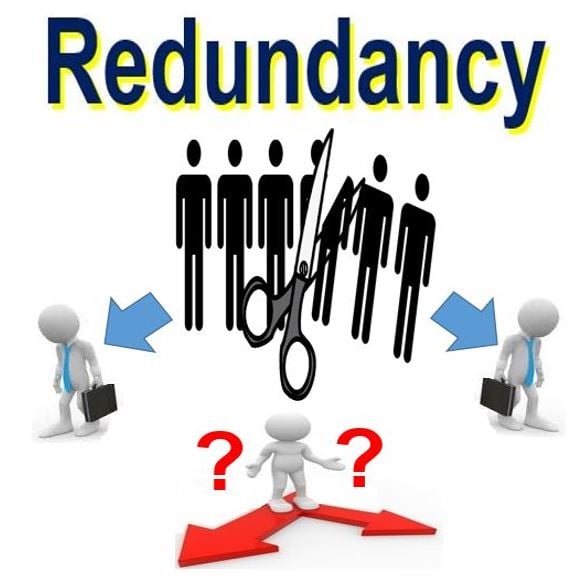Exploring the Interplay In Between Company Redundancy and Business Adaptability for Future Development
In the vibrant landscape of today's business world, the elaborate connection between business redundancy and organizational versatility arises as a critical factor for sustained growth and success. Companies typically encounter the obstacle of striking a fragile equilibrium in between keeping a degree of redundancy to minimize threats and cultivating flexibility to react promptly to the ever-evolving market needs.
Value of Firm Redundancy
Business redundancy is a vital component that improves business resilience and mitigates operational threats. By including redundancy actions within the business framework, companies can much better stand up to unforeseen disruptions and fluctuations in the service environment. Redundancy works as a calculated buffer, allowing companies to adjust and respond efficiently to unexpected obstacles without endangering necessary procedures.
One key facet of the relevance of business redundancy is its role in ensuring connection during times of situation. When confronted with unexpected changes or emergency situations, redundant systems, sources, or workers can action in to keep important features and stop widespread disturbances. This continuity not just safeguards the business's reputation and consumer count on yet likewise minimizes economic losses and operational downtime.

Approaches for Business Flexibility

Producing adaptable business frameworks that allow for quick changes to market dynamics and client needs is essential for remaining affordable in a swiftly evolving setting. By proactively determining potential disturbances and opportunities, companies can proactively adjust and flourish in an ever-changing company landscape.
Harmonizing Redundancy and Versatility
Achieving an unified balance in between functional redundancy and organizational adaptability is extremely important in navigating the intricacies of a dynamic business atmosphere. Redundancy within a company supplies a safety web, guaranteeing connection and stability in operations. However, an excess of redundancy can result in inefficiencies and impede adaptability to altering market problems. On the other hand, business adaptability enables companies to respond without delay to external interruptions and confiscate new possibilities. Striking the right equilibrium between redundancy and versatility is a fragile process that needs a deep understanding of the company's goals, market characteristics, and risk tolerance.
To accomplish this equilibrium, business need to carry out routine evaluations of their operations to identify areas where redundancy is necessary for danger mitigation and where adaptability can drive development and growth. Implementing flexible frameworks, cultivating a society of constant knowing and renovation, and encouraging open communication throughout all degrees of the organization are essential techniques to harmonize redundancy and flexibility properly. By lining up these two vital components, firms can position themselves for sustainable development and success in an ever-changing service landscape.
Situation Studies on Adjustment Success
In taking a look at instances of successful organizational adaptation, it ends up being obvious that the interaction in between operational redundancy and adaptability is a defining factor in shaping resilient companies. A DVD rental service, Netflix demonstrated exceptional versatility by transitioning right into a streaming system when digitalization interfered with the sector. These case studies underscore the significance of operational redundancy coupled with business flexibility in cultivating lasting development and competitiveness.
Building Resilience for Future Growth
Building resilience for future development needs a tactical positioning of functional procedures with market characteristics and arising patterns. Business should adapt to transforming settings by promoting a culture of flexibility, see post technology, and continual enhancement. Resilience involves not only recovering from obstacles however also proactively planning for future obstacles. One essential aspect of structure durability is buying durable danger administration strategies to minimize prospective disruptions. This consists of situation preparation, branching out supply chains, and developing backup plans for numerous contingencies (who pays redundancy money).
Moreover, promoting solid relationships with stakeholders, such as clients, employees, distributors, and the neighborhood, is essential for preserving and weathering unpredictabilities trust and support throughout turbulent times. Efficient interaction and openness play an important role in structure strength, as they help help directory with and straighten assumptions collaboration in navigating uncertainties.
In addition, companies require to prioritize understanding and development initiatives to upskill workers and furnish them with the essential devices to adjust to changing situations. By investing in their workforce, business can improve their flexibility and agility, ultimately strengthening their durability for sustainable future growth.
Final Thought

In the vibrant landscape of today's business world, the complex relationship between business redundancy and business adaptability arises as a crucial element for continual development and success. Companies commonly deal with the challenge of striking a delicate balance in between keeping a level of redundancy to reduce dangers and cultivating adaptability to respond quickly to the ever-evolving market needs.To attain this equilibrium, companies need to carry out regular assessments of their operations to determine locations where redundancy is essential for threat mitigation and where adaptability can drive development and growth.In final thought, the interaction between business redundancy and organizational versatility is critical for future growth. Building web resilience through a combination of redundancy and adaptability will ensure that companies are prepared for the challenges of the future.